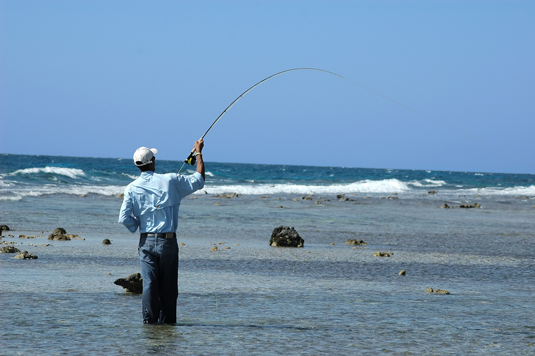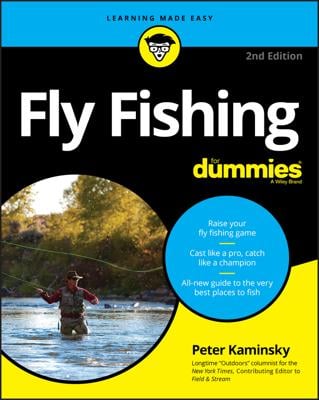Stalking a bonefish or permit has the same kind of hold-your-breath thrill as casting a dry fly to a feeding brown trout. Often you know you’ll get just one shot, so it can’t be a clumsy one.
 © mountainpix / Shutterstock.com
© mountainpix / Shutterstock.comThe Florida Keys: More Than Margaritaville
Fly rodders have been fishing the Keys for decades. There is still good fishing here, although the fish are no longer as naïve and eager to bite as they are in some of the globe’s more remote places. Keys bonefish are super-educated and will challenge skilled anglers. You’ll also find healthy numbers of permit. Here, as elsewhere, they can be maddeningly finicky. The tarpon that migrate up and down the coast will get your heart pounding. You can see them coming from very far away, like wolf packs bearing down on you. Somehow the Keys still feel comfortably old timey and slow paced. And then there is the key lime pie!Lands of the Maya: The Yucatan and Belize
The shores of the Yucatan and Belize comprise thousands of square miles of white sandy flats where you can stalk bonefish, tarpon, permit, and sometimes snook from a shallow draft boat or, better yet, on foot. To be sure, the condos and resorts that have spread out along the Mayan Riviera have had a not-great effect on the fishing in some spots, but still Boca Paila, Punta Allen, and, in recent years, the relatively unspoiled Holbox park are accessible and productive. Further south, Belize, in many spots, is like the Yucatan minus 50 years.The Bahamas
In the years following World War II, when winter-weary anglers began to fly south for their fly fishing, modern flats fishing came of age in the Bahamas. It’s still pretty amazing. South Andros has a well-earned reputation for big bonefish in great numbers. Ditto Mangrove Cay. The legendary Walker’s Cay was decimated by a hurricane, but Mother Nature is nothing if not resilient, and Walker’s is worth a pilgrimage. Rule of thumb: Almost anywhere with white sandy flats will have bones, permit, and probably snook and tarpon as well. Unless you’re a pro, you definitely need a guide to help you play the tides.Cuba, Sí
Sixty years ago, baseball immortal Ted Williams caught 71 bonefish in a day’s fishing on The Isle of Pines (since renamed The Isle of Youth). I think that’s a bonefish record that will stand forever. The “good news” (at least for anglers) is that the sorely pressed economy of Cuba has kept the pace of development down. You can still fish mile after mile of undisturbed water and see little that has changed in the five centuries since Columbus first landed here. Sipping a mojito after a day’s fishing is even more fun while being serenaded by a high-energy Cuban combo. The cigars ain’t bad either.Kiritimati: That’s Christmas Island to You
Kiritimati is the world’s largest atoll and the first of the remote Pacific bonefishing places to catch the attention of flats fishers. It’s a long, thin island that’s not near anything, right in the middle of the ocean and nearly smack dab on the equator. There are endless wadeable flats with tailing bonefish on every one. By accident I caught my first giant trevally here when it decided to eat the bonefish at the end of my line.The Seychelles: Far Away, and That’s Good
It was just a matter of time until the upsurge in fly fishing brought anglers to this string of islands off the East Coast of Africa. There are jaw-dropping numbers of bonefish, Indo-Pacific permit, and giant trevally that can be . . . well . . . giant. There is no more exotic location in the world, and once you have come all this way, a visit to the Serengeti with its teeming wildlife is one of our planet’s great spectacles.Montauk : A Frenzy of Fish (and Fishermen)
The East Coast of the United States, from Cape Cod to Sandy Hook, has superb fly fishing. The coastal wetlands are a breeding ground for billions of baitfish, and the Gulf Stream, just offshore, funnels migrating stripers, bluefish, weakfish, false albacore, and tuna into a relatively narrow corridor. Quite often, you will find game fish next to the shore, or close to it, as they pen up schools of bait.If I had to pick just one place along this coast, without question, it would be the waters around Montauk, which is a choke point for everything in the north Atlantic that migrates south. Whether you fish the flats as you would for bonefish or choose to come when the migration is going full-tilt and the surf action is gonzo, Montauk is a world-class destination, yet so close to New York City.

